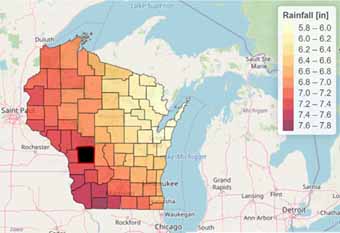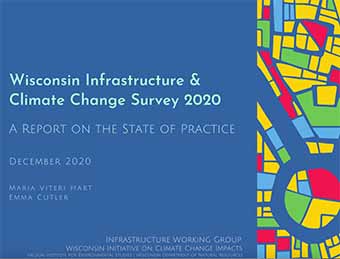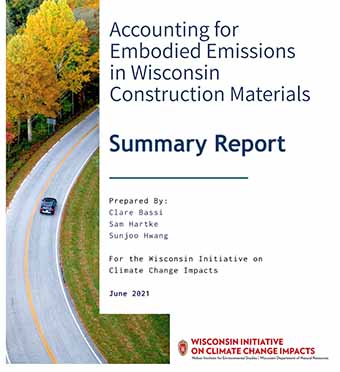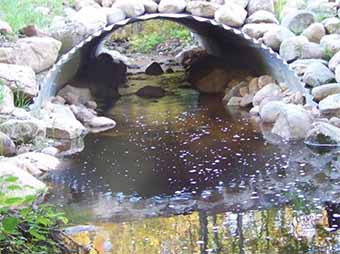The initiatives, identified by the Infrastructure Working Group (IWG), are issue-driven.
Wisconsin Rainfall Project
- Leader: Daniel Wright, Infrastructure Working Group Co-Chair
- Product: Rainfall Data Portal
- Supporting documents:
- Presentations: Climate Change and Rainfall IDF Statistics, Environmental and Water Resources Institute (ASCE), Oct 29, 2021: video and PowerPoint slides
- Additional Resources:

The Wisconsin Rainfall Project provides up-to-date rainfall statistics — often referred to as design storms — that take into account the extreme rainfalls we’ve seen in recent decades. Additionally, the project offers projections of rainfall statistics for time horizons to the end of the 21st century using the results of climate models.
Note: Depending on the risk posed by failure and related regulations, design storms can range from five-year or 10-year events for storm sewers to as large as a 500-year storm for a dam’s spillway. For example, a five-year event has a one-in-five, or 20 percent, probability of occurring in any particular year.
The Wisconsin Rainfall Project website portal allows users to view current and future rainfall statistics for any county in Wisconsin. These new rainfall data are often significantly different than existing statistical references, such as those from the U.S. National Weather Service, that are required in many codes and ordinances.
Best practices for using results from the Wisconsin Rainfall Project need to be worked out collaboratively with designers and regulators. Discussions with state agencies and interest groups on the use of updated and future rainfall statistics began in the fall of 2021 and are ongoing.
Wisconsin Infrastructure and Climate Change Survey
- Leader: Maria Hart, Infrastructure Working Group co-chair
- Product: Wisconsin Infrastructure & Climate Change Survey 2020: A Report on the State of Practice (pdf)
- Images: Larger versions of the figures used in the report
- Presentation: Summary of Wisconsin Infrastructure and Climate Change Survey (PowerPoint)
 The WICCI Infrastructure Working Group (IWG) surveyed Wisconsin public infrastructure managers, planners, elected officials, and consultants during the fall of 2020 to confirm IWG’s research priorities and products were in line with infrastructure managers’ needs across the state. The survey report provides a baseline assessment of the state of practice in Wisconsin municipalities, including issues ranking and barrier identification. Lastly, the survey produces data to support grant funding for climate change resilience planning for Wisconsin municipalities.
The WICCI Infrastructure Working Group (IWG) surveyed Wisconsin public infrastructure managers, planners, elected officials, and consultants during the fall of 2020 to confirm IWG’s research priorities and products were in line with infrastructure managers’ needs across the state. The survey report provides a baseline assessment of the state of practice in Wisconsin municipalities, including issues ranking and barrier identification. Lastly, the survey produces data to support grant funding for climate change resilience planning for Wisconsin municipalities.
Top research priorities identified by survey respondents include:
- Developing technical data such as statistically based descriptions of future precipitation and temperature and other climate effects for use in design
- Summarizing and distributing information on infrastructure design approaches
- Using and measuring nature-based solutions
- Providing guidance on design approaches for culvert and hydraulic opening size taking into account climate change
- Working to initiate a state compact that provides the policy framework, adaption metrics and tools that Wisconsin municipalities can adopt to jump-start climate change planning
- Developing courses on climate change/adaptation/mitigation for municipal employees
- Summarizing best practices on how to communicate climate change to generate buy-in
The survey results will be presented to agencies and professional groups in the spring of 2021.
The Embodied Carbon Emissions of Construction Materials
- Leaders: Bu Wang, Infrastructure Working Group co-chair, and Rob Montgomery, chair
- Products:
 Many Wisconsin municipalities have embarked on Climate Action Plans, looking for ways to reduce (mitigate) greenhouse gas emissions to diminish their carbon footprint. Actions like switching to solar or other renewables and upgrading fleets to hybrid or electric could be enhanced by planning to reduce the carbon footprint of their infrastructure projects.
Many Wisconsin municipalities have embarked on Climate Action Plans, looking for ways to reduce (mitigate) greenhouse gas emissions to diminish their carbon footprint. Actions like switching to solar or other renewables and upgrading fleets to hybrid or electric could be enhanced by planning to reduce the carbon footprint of their infrastructure projects.
Embodied carbon emissions of construction materials constitute a major portion of the carbon footprint of infrastructure projects. These emissions are produced from mining of raw materials, manufacturing, transportation, and the construction process itself. The emissions embodied in construction materials are surprisingly large – just concrete and steel alone account for more than 20 percent of global greenhouse gas emissions. To be informed about and eventually reduce this impact, the first step is to properly quantify the emissions embodied by materials like concrete, steel and asphalt. This is a complex process, and will involve collaboration between owners, designers, contractors and material suppliers.
For this project, the IWG partnered with UW-Madison researchers to describe a research program (pdf) for characterizing the embodied carbon emissions of construction materials used in Wisconsin. The first part of the work was completed in spring 2021 by graduate students in the UW-Madison Energy Analysis and Policy Certificate Capstone program. This work produced guidance to help owners and contractors get started.
Bu Wang, the IWG lead on this project, said, “Once we quantify embodied carbon emissions, we can develop the policies, specifications, and contracting procedures to reduce or offset these carbon emissions.”
Although an Environmental Product Declaration (EPD) is established as the standard method to calculate and disclose the cradle to gate environmental impact of a product, complex issues must be addressed before it can be applied to mitigate carbon emissions. These issues include ensuring consistency in emission calculations among different suppliers and materials, establishing appropriate Product Category Rules (PCRs), taking into account life-cycle emissions after construction, etc.
Work on this project is expected to continue in 2021 and 2022.
Flood-Resilient Road Stream Crossings

Leadership: Christopher Ester, christopher.ester@usda.gov, chairs the IWG Stream Crossings Committee comprised of technical staff from 11 different Wisconsin-based agencies and organizations with significant experience in planning, designing, and building road stream crossing replacements with flood resilience considerations.
Problem statement: The accelerated occurrence of high-intensity rain events across the state is causing existing road stream crossing infrastructure to fail, increasing long-term maintenance costs, and degrading public waterway and wetland resources including fish and other aquatic organisms.
Activities:
- Promote the design and construction of flood resilient road stream crossing structures
- Recommend design method — US Forest Service “Stream Simulation” Design (pdf) — and culvert inventory method — Great Lakes Stream Crossing Inventory — that are informed by stream geomorphology and watershed hydrology indicators
- Provide resources to road management agencies and stakeholders including tools to prioritize crossing replacement projects and technical and financial assistance to upgrade vulnerable road stream crossings with flood resilient structures
Implementation of these strategies would result in broad benefits including long-term cost savings, reduced maintenance needs, safer roadways, and higher quality and healthier waterways, wetlands, and fisheries.
Products: